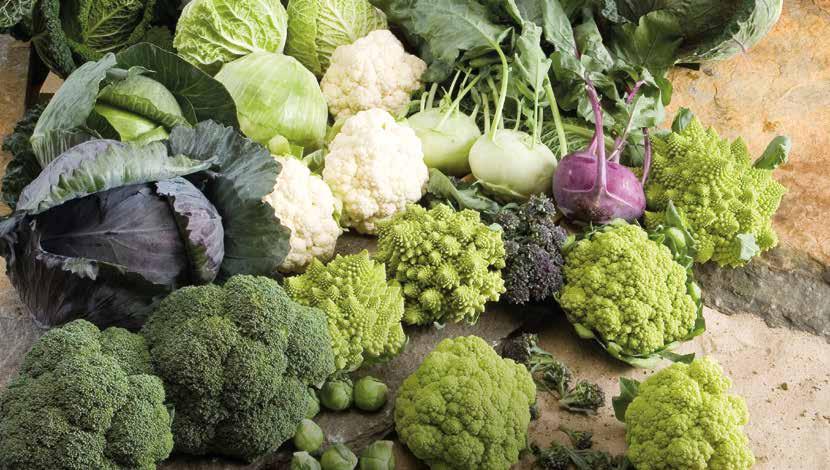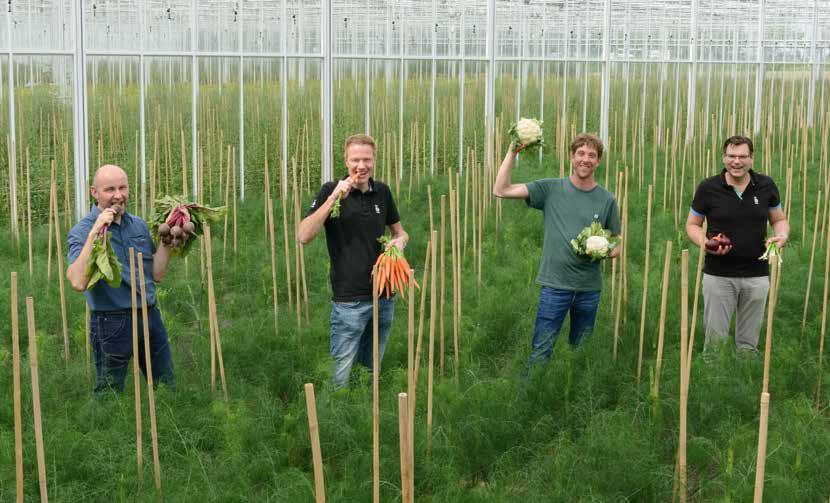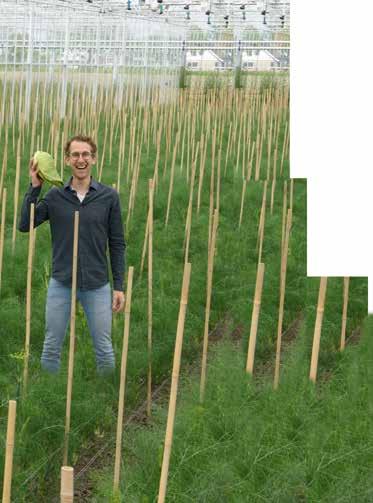
11 minute read
BREEDERS HAVE GENETICS ON THEIR SIDE
ORGANIC AND CONVENTIONAL COMPLEMENT EACH OTHER
BREEDERS HAVE GENETICS ON THEIR SIDE
BREEDERS ARE ALWAYS LOOKING FOR NEW WAYS TO IMPROVE CROP VIGOUR AND HEALTH. THE ORGANIC SECTOR BENEFITS FROM BREEDERS’ EXPERIENCE WITH CONVENTIONAL CULTIVATION, WHILE ORGANIC GROWING CAN LEAD THE WAY TOWARD INNOVATION AND SUSTAINABILITY IN THE TRADITIONAL SEGMENT. ‘WE STRIVE FOR A WHOLE PACKAGE INTO WHICH WE STACK AS MANY RESISTANCES AND TOLERANCES TO FUNGAL INFECTIONS, BACTERIA AND INSECTS AS WE CAN.’
“We are working on the resistance of brassicas to fungal diseases.”
Jan-Sybe Wijngaarden In the 1980s, Bejo discovered a source of resistance to downy mildew, found in a wild onion. Our breeders saw the potential. After all, the fungus (Peronospora destructor) can cause a lot of damage. They included the resistant wild variety in their crossing and selection programs. In the early 2000s, after 20 years, their work paid off with the development of the first highly resistant yellow onion.
Conventional growers didn’t show much interest at first. At the time, they had good chemical agents for keeping downy mildew under control. The rapidly growing organic sector, on the other hand, welcomed the new variety with open arms. After all, without fungicides they could only do one thing in the event of an infection: harvest as soon as possible. As a result, their yield was completely unpredictable: a grower who achieved 50 tons per hectare in a good year might not get more than 5 tons if an outbreak hit. Such large fluctuations are disastrous for mainstream retail sales.
That changed with the introduction of varieties with a high resistance to downy mildew, such as the yellow onion Hylander and later the red onion Redlander. Growers can now count on a steady annual yield of at least 25 to 40 tons per hectare. This continuity in supply has delivered a breakthrough for organic onions in traditional supermarkets, especially in Germany. The conventional sector is following close behind. In France, for example, chemical control of downy mildew is under scrutiny and the retail >>
fltr: Jack van Dorp, Wim Zwaan, Jan Sybe Wijngaarden, Timo Petter and Bert Janssen

HYBRIDIZATION
Modern breeding generally uses hybrid varieties. A hybrid is a crossing of two parental lines, each of which has been selected and developed to emphasize certain characteristics. A targeted combination of two lines produces a next generation (F1) that outperforms either parent. Hybrid varieties are vigorous, get off to a fast start and develop evenly. They suit efficient, mechanized cultivation methods and meet demand for a reliable supply of a uniform product.
The refinement of specific characteristics or the introduction of a new characteristic, such as disease resistance, can be done more quickly through hybrid breeding. Hybrid varieties can’t be used for seed propagation. Within organic agriculture there is a small movement that prefers to use only open-pollinated varieties. The markets in which Bejo’s customers are active work with hybrid varieties. market is looking for resistant onion varieties. Based on the same genetic source, Bejo has now also developed a variety for onion sets (Boga) and seed shallot (Innovator).
Organic and conventional play to each other’s strengths
The example of highly resistant onions shows that breeding for the organic sector benefits from efforts in conventional growing. Timo Petter, Crop Research Manager at Bejo, comments: “When we started working
“Healthy foliage keeps the crop greener, and that means better overall resistance”
Wim Zwaan
“We strive for a combined variety into which we stack as many resistances and tolerances for fungi, bacteria and insects as possible.”

Bert Janssen
on onions in the 1980s, we were looking at applications in conventional growing. Otherwise it wouldn’t have occurred to us, because in those days organic was nowhere near the big market that it is now. As it turned out, the variety succeeded in response to increased demand from the organic side.” Bejo’s breeders work for the organic and conventional markets simultaneously, and that makes sense, because both markets want progress in the same characteristics. Petter says: “Conventional growing is shifting towards organic. The use of artificial fertilizers and chemical crop protection products is already limited, and the trend is expected to continue. Breeding supports the move toward sustainability. If you have genetics on your side, you don’t need chemistry.”
Fusarium
The conventional market can learn from organic growers’ experience in working without chemicals. Conversely, the organic sector can find solutions more quickly because breeders can draw on the varieties and parent lines that Bejo has developed over decades of conventional breeding. Sometimes the answer is already on the shelf. Petter mentions the soil fungus Fusarium as an example. “Until recently, Fusarium rarely caused problems on organic farms. We now see that changing. The good news is that we started looking for resistance in our programs 20 years ago, because this was already an issue in conventional cultivation.” >>
NATURAL AND INDUCED CMS
In hybrid breeding, a targeted crossing of two parent lines yields a variety with the desired characteristics. To prevent self-pollination in the maternal line, seed breeders use so-called cytoplasmic male sterility (CMS for short).
Preventing self-pollination in the maternal line using male sterility has clear advantages for growers. The seed is more uniform and the crop produces a better yield. For seed production it means fewer losses, hence more sustainable agriculture.
In many crops, such as carrots, onions and leeks, CMS occurs as a natural trait and is crossed by breeders into the parental lines. Other crops, especially brassicas and rooted parsley, lack natural male sterility. The solution comes from an artificial technique called protoplast fusion.
The European and American guidelines for organic farming allow the use of induced CMS. However, biodynamic cultivation requires ‘CMS-free’ varieties. A number of important market participants in some areas, such as Germany, do not accept induced CMS. Bejo is transparent about its use of CMS in protoplast fusion. For the crops in which it is used, a CMS-free alternative is always available.
Researchers are currently studying ways to naturally crossbreed male sterility into maternal lines in brassicas. This has already been done in cauliflower, leading to the development of a new variety with natural CMS, which is still in the testing phase.
“Conventional growing is shifting towards organic.”
Timo Petter
NUMBER OF TESTS AND VARIETIES PER YEAR
As a supplier of seeds for open field vegetable cultivation, Bejo has a range of more than 40 different crops and over 1000 varieties. Of those, over 35 crops and 170 varieties are produced specifically for organic cultivation, and those numbers are growing.
Plant breeders are constantly looking for varieties with even better performance or attractive new characteristics. Before a particular hybrid can become a new variety, it must undergo years of intensive testing under diverse conditions. Here are two examples: For carrots, Bejo carries out 40,000 such tests at 120 locations on several continents. This produces roughly three to four new varieties each year, the most suitable of which are also intended for the organic market. For alliums, Bejo sows some 46,000 plots per year in breeding trials worldwide, for both conventional and organic. This yields about 10 new varieties each year.
A breeder’s work is never done
Breeding will always be a work in progress. Crop resilience keeps coming up against new challenges, including more intensive land use and the consequences of climate change. Besides, resistances are never absolute and can be penetrated if a pathogen finds an opportunity. Each crop presents different problems. In carrots, for example, breeders are alert for foliage diseases such as leaf blight (Alternaria dauci), Cercospora and powdery mildew. “Healthy foliage keeps the crop greener, and that means better overall resistance”, says Wim Zwaan, Breeding Manager for carrots. He also strives for better resistance to storage diseases such as black rot (Alternaria radicina) and soil-borne diseases such as cavity spot (Pythium). “Carrot cultivation is becoming more intensive and the rotations are getting tighter. As a result, there is an increasing demand for highly tolerant varieties. For example, our cavity spot tolerant varieties Norfok and Nazareth are popular in England.”
Brassicas
In cauliflower, broccoli and headed cabbage, breeders are working on resistance to the fungal diseases ring spot (Mycosphaerella) and downy mildew. Other targets are resistance to the bacterial infection Xanthomonas in headed cabbage and summer cauliflower and the fungal disease light leaf spot in Brussels sprouts, says Breeding Manager Jan Sybe Wijngaarden.
Celery and beetroot
In celery, the relatively recent variety Cumbia appears to be an asset, thanks to a good tolerance against leaf spot disease Septoria, says Jack van Dorp, Breeding Manager for crops including celery and beetroot. The leaf spot disease Cercospora and the virus infection Rhizomania are also common problems in beetroot. “Our Bazzu variety shows the great strides that we’ve already taken. And more will follow. In a number of breeding lines we see the level of tolerance for Cercospora increasing. Crossing resistances into our varieties is a continuous process. We especially focus on combining resistances to arrive at more sustainable solutions.” Plant resilience doesn’t just come from one single defence mechanism. For storage diseases in celeriac, for example, the shape and hardness of the corm are factors worth looking at. “Any damage during harvesting is a potential gateway for infections,” says Van Dorp. “Bejo is currently testing a promising new variety for the fresh-grown market with a round, smooth, attractive shape.”
Insects
The big challenge for the future is how to deal with insects, including aphids, carrot fly, whitefly, thrips and diamondback moth (Plutella). Some plants have natural defences against insects, and it is up to the breeders to identify those traits and cross them into commercial varieties. This work is taking place in all crop categories, and not just in organic varieties. In headed cabbage, for example, solutions are needed almost as urgently in conventional cultivation. Pests tend to shelter inside the rounded leaves, out of reach of chemicals. That’s especially true of thrips, which are notorious for doing damage to headed cabbages, says Breeding Manager for headed cabbage Bert Janssen.
GENE EDITING CAN ACCELERATE SUSTAINABILITY
‘Classical’ breeding is a question of patience. It requires many generations of plant selection, crossing and testing. To develop a new variety often takes 15 to 20 years. This can be done much faster with gene editing (such as CrisprCAS), in which certain combinations of genetic properties can be produced in a laboratory.
Gene editing differs from genetic modification, sometimes called GMO technology. Gene editing creates only combinations that could have been created with natural, ‘classic’ breeding techniques. In genetically modified organisms, GMOs for short, non-species properties can be crossed into a plant artificially. GMO technology is subject to strict regulation in most countries, and regulated GMOs are highly uncommon in vegetable crops. Under European law they are not allowed at all.
The EU currently also bans gene editing, treating it as a form of GMO technology. The European Commission recently announced that it plans to reconsider the ban. Plantum, the Dutch trade association for the plant breeding sector, of which Bejo is a member, applauds this re-evaluation.
Since early 2021, Bejo has had the opportunity to conduct research into the application of gene editing, under a research and licensing agreement with US partners. Use of this technology in the development of varieties will be considered only if it is permitted under current law. European regulation continues to guide the organic sector.
Stacking resistances and tolerances
The more health traits a variety can combine, Janssen explains, the more valuable it is. Janssen says: “We strive for a whole package into which we stack as many resistances and tolerances to fungal infections, bacteria and insects as we can. Our white cabbage Expect is widely appreciated for its tolerance to thrips.” Along with tolerances, other properties are also useful for a healthy crop. Carrot breeder Zwaan mentions vigour as an example. “In carrot cultivation, you want the crop to grow out quickly and uniformly. That way you don’t need to irrigate as much and can suppress weeds more easily.”
Visual quality
But robust plant growth isn’t the only issue. In the fresh segment in particular, organic growers can seldom afford to compromise on the visual characteristics of the product. Zwaan says: “Consumers no longer accept raw carrots with spots. Certainly not in the supermarket, where organic and conventional produce is sold side by side. If the cheaper conventional product also looks better, shoppers are less likely to choose organic.”
Bejo will introduce a new variety only if it has added value on a certain characteristic while still performing at least as well as existing varieties. Wijngaarden says: “When you order seed for your growing operation, you don’t yet know what challenges the coming season will bring. That’s why you need reliable varieties that give good results under a range of conditions. With that in mind, we aim for varieties that score a 7 for each characteristic, instead of a lot of tens plus a 2 or a 3.”
“Any damage during harvesting is a potential gateway for infection.”
Jack van Dorp










